Among all the knitting patterns, shadow patterns are considered the simplest. To perform them, you only need to know 2 types of loops: front and back. Using a combination of 2 types of loops, you can decorate products for both children and adults. At the same time, for such a pattern you can use only 1 color of yarn.
What are shadow patterns
Shadow knitting, the patterns of which are suitable for beginners, is associated with the play of light and shadow. With a certain alternation of purl and face loops, you can get a pattern. With such patterns you can begin to get acquainted with knitting.
In this type of knitting, density is very important, because it is the final appearance of the product that depends on it. If the front loops are not neat enough, this will be noticeable in the shadow knitting pattern.
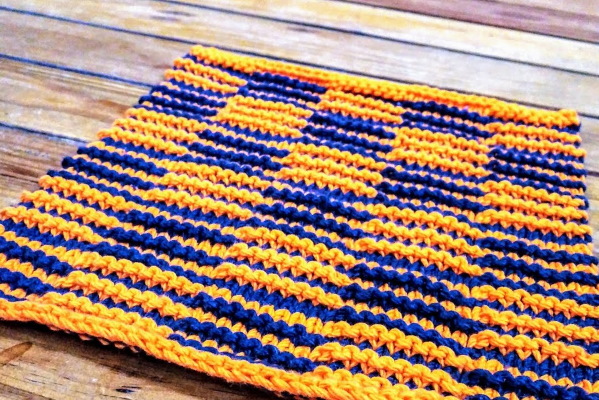
The essence of making patterns is that it is necessary to alternate purl and front loops. Most often, the pattern on the front side is knitted with knit stitches, and the background is knitted with purl stitches. Thus, on the back side, the loops are knitted according to the pattern, obtaining its shadow.
Yarn for shadow knitting
Since the cost of yarn is quite high, many needlewomen strive to find budget and high-quality yarn for their work. This is also important because a sweater or blanket requires not 1 skein, but at least 3.
The table below shows inexpensive yarn options that can be used in shadow knitting. In the works, you can use yarn from both Russia and foreign manufacturers.
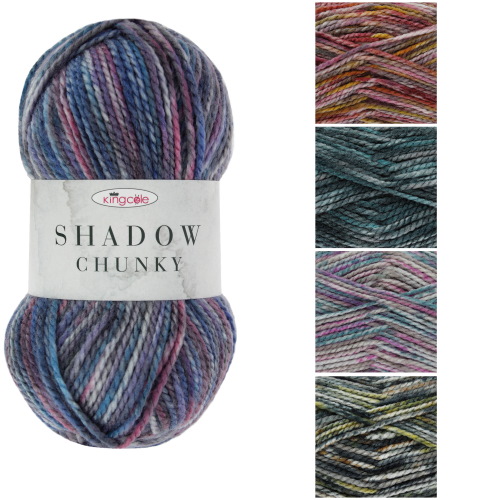
| Name of yarn | Brief description, composition | Price (per 1 skein) |
| Pekhorka "Severnaya" | 40% acrylic, 30% angora, 30% wool. Warm yarn for knitting winter clothes. | 130 rub. |
| Pekhorka "Winter Premiere" | 50% merino wool, 50% acrylic. Light and bulky yarn for winter items. | 220 rub. |
| Pekhorka "Folk Tradition" | 30% wool, 70% acrylic. With this thread you can knit warm and voluminous things for both children and adults. | 160 rub. |
| Pekhorka "Autumn" | 75% polyacrylonitrile, 25% wool. Knitted yarn for scarves, hats or snoods. | 350 rub. |
| Trinity yarn "LANA GRACE Grande" | 75% acrylic, 25% merino wool. Blended yarn for knitting items with large patterns. Soft and lightweight yarn, has a high volume. | 160 rub. |
| Trinity yarn "Merinos Canberra" | 50% merino wool, 50% acrylic. Yarn for knitting blankets and rugs. Soft and elastic yarn that does not prickle. | 210 rub. |
| Kamtex "Pyshka" | 100% semi-fine wool. Thick and warm yarn, which is suitable for knitting winter and autumn items. Due to its thickness, it allows you to highlight patterns and make them more expressive. | 190 rub. |
| Kamtex "Budget" | 60% acrylic, 40% wool. Warm and soft yarn for knitting winter clothing. | 100 rub. |
| Alpina "Garry" | 100% mercerized cotton. Yarn for knitting summer clothes, such as cardigans, bags. | 170 rub. |
| Nako "Arctic" | 40% wool, 60% acrylic. Thick yarn for knitting winter wardrobe items. Due to the thickness of the yarn, the patterns are embossed and expressive. | 150 rub. |
| Nako "Jersey" | 30% wool, 70% acrylic. Yarn for voluminous and warm items. It can be used to knit snoods, scarves and vests. | 110 rub. |
Knitting tips and tricks
When choosing materials, it is better to give preference to smooth threads that include acrylic. This will prevent the threads from rolling.
To make knitting denser and more elastic, it is better to knit with needles 1 size smaller than recommended in the instructions or by the manufacturer. If the work is too loose, the pattern will be too blurry. Some elements of the pattern can be highlighted with a different shade of yarn, however, this is left to the discretion of the needlewoman.
Using shadow patterns
Not all images are suitable for shadow knitting: for this type of knitting, it is best to use large images. Not all patterns with small details can be used, as this can complicate the knitting process and distort the contrast of the image.
Popular patterns in shadow knitting:
- Geometric motifs;
- Landscapes;
- Still lifes.
For knitting with front and back loops, thick and bulky yarn is suitable, as it will help to highlight the pattern better. The needles are selected 1 or 1.5 numbers smaller than recommended. This choice will help make the fabric less loose. Since the patterns do not look so bright, they may appeal not only to women, but also to men.
Shadow knitting, the patterns of which are used in the creation of clothing, can be used to create blankets and capes. For knitting blankets and capes, thick and strong yarn is used, which allows you to better highlight the pattern and make it more original. This does not require several shades of yarn, you can use only 1 color.

 | 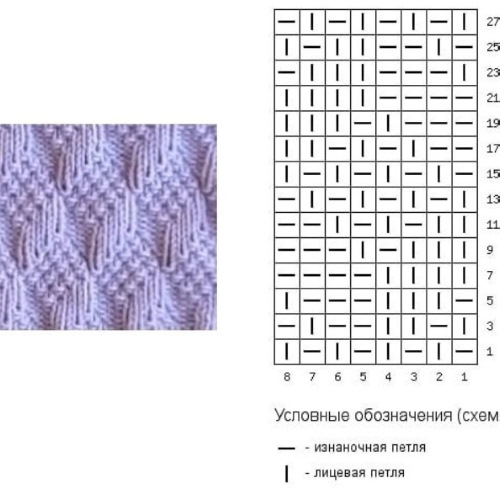 |
Shadow knitting has a number of advantages, which include:
- Ease of implementation;
- Speed of product creation;
- Universality – the patterns will appeal to men, women and children;
- Saving yarn – you only need yarn of one color for the project.
Reading schematics
Shadow knitting, the patterns of which are popular among needlewomen, consists of front loops (LP) and back loops (IP). To avoid mistakes when working, it is very important to learn how to read patterns. If you get confused when knitting loops, the pattern will be distorted and the appearance of the product will be spoiled.
White cells on the diagram denote lp. Dark color denotes ip. This principle applies to the front rows. In even, back rows, white cells denote ip, and dark ones denote lp. The difference between the rows is also that on the front rows, the dark places will be more voluminous, while the light ones will not. On the back side, the fabric will be voluminous in the light places.
An example of a diagram with the final result is presented above.
Master class on knitting shadow patterns with diagrams
The patterns of shadow knitting are read in such a way that the front loops make up the fabric, and the back loops make up the pattern. The resulting pattern will be three-dimensional and will be visible from all sides. What is interesting about shadow patterns is that each cell in the pattern is a loop in 2 rows at once.
As a pattern used to decorate the product, you can use the triangle pattern. Additionally, edge loops may be required for the work. The number of loops should be divisible by 10.
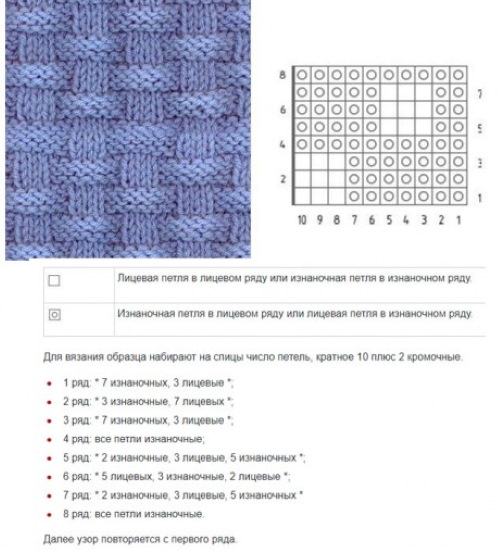 |  |
 | 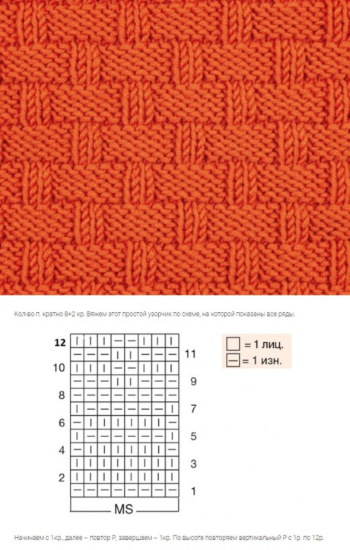 |
 | 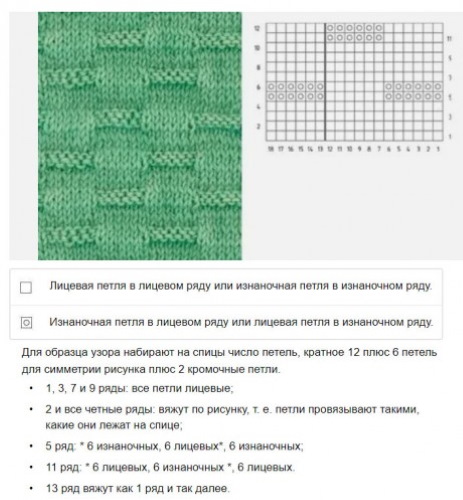 |
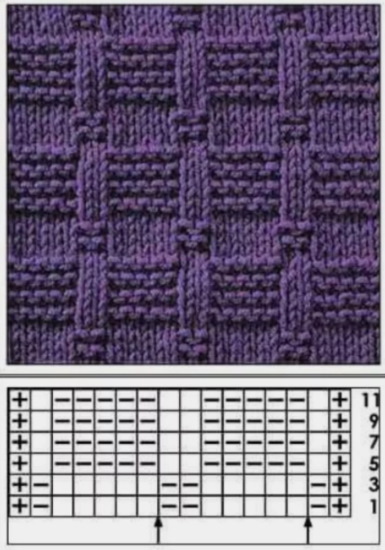 | 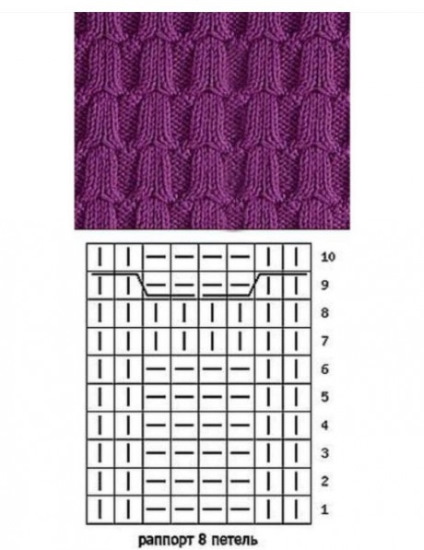 |
The pattern is knitted according to the diagram:
- 1 row – knit LP, 4 ip, LP, 4 ip, LP.
- Row 2, like all even rows, knit according to the pattern.
- Row 3 – knit 2 LP, 7 ip, 2 LP.
- Row 5 – knit 3 knit stitches, 5 ip, 3 knit stitches.
- Row 7 – knit 4 knit stitches, 3 ip, 4 knit stitches.
- Row 9 – form ip, 4 knits, ip, 4 knits, ip.
- Row 11 – knit 2 ip, 7 knit, 2 ip.
- Row 13 – knit 3 ip, 5 knit, 3 ip.
- Row 15 – knit 4 ip, 3 knit, 4 ip.
- Row 17 is knitted according to the principle of row 1.
The result of knitting looks like this:

Not only triangles can decorate knitted items. Thus, in work you can use circles, zigzags, diamonds, and rectangles. The simpler the pattern, the easier it is to knit. Another pattern suitable for decorating a blanket, bedspread or sweater is a braid. It is made up of interlacing stripes and threads.

To knit a braid, you will need yarn of the chosen color and 3 knitting needles:
- Cast on 8 stitches onto the knitting needle.
- Knit 1 row, slipping the edge loop, transfer 2 loops to an additional knitting needle and leave before the row. Knit 2 knit stitches, 2 additional loops, edge loop.
- Rows 2, 4 and 6 knit ip.
- In row 3, knit 2 knit stitches, 2 loops on an additional needle, 2 knit stitches, 2 knit stitches from spare loops.
- Row 5 is knitted in the same way as row 1.
Blankets
Shadow knitting, the patterns of which are used not only by beginners but also by experienced needlewomen, can help in creating gifts for various holidays. For example, a blanket with several hearts can be a gift for Valentine's Day.
For one square of such a blanket, you need to cast on 25 loops, 19 of which will make up the pattern. Knit 19 loops according to the pattern below. To assemble the blanket as a whole, you need to knit the required number of squares and sew them into a single piece.
The blanket can be decorated with diamonds made using shadow knitting. For this, you will need yarn and knitting needles. It can be inscribed in another figure, or it can be single.
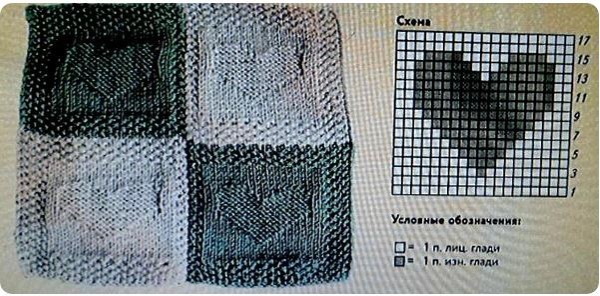
The blanket can be knitted according to the following pattern and master class:
- Taking into account the edge loops, cast on 17 loops.
- Knit 1 row.
- Starting from the 2nd row, knit a shadow pattern. To do this, after the edge knit 7 knit stitches, ip, 7 knit stitches and an edge stitch.
- Knit row 3 and the remaining odd rows according to the pattern.
- Row 4 begins with an edge loop, after which knit ip, 5 knit stitches, ip, knit stitch, ip, 3 knit stitches and an edge loop.
- Each row begins and ends with an edge loop.
- Knit row 5: knit stitch, ip, 3 knit stitch, ip, 3 knit stitch, ip, 2 knit stitches.
- Row 7: knit 2 knit stitches, ip, knit stitch, ip, 5 knit stitches, ip and knit stitch.
- In the 9th row, knit 3 knit stitches, ip, 7 knit stitches, ip.
- In the 11th row, knit 2 knit stitches, ip, knit stitch, ip, 5 knit stitches, ip and knit stitch.
- To create row 13, knit 1, p, 3 k1, p, 3 k1, p and 2 k1.
- Row 15 is knitted with ip 5 lp, ip, lp, lp and 3 lp.
Cap
With the help of the crown pattern, you can decorate both a child's and an adult's hat. The simplicity of the pattern is that several colors of yarn are not required to make the crown, such a bright and unusual pattern can be created only from yarn of 1 color, for example, yellow.

To knit such a pattern on a hat, you need:
- Taking into account the edge loops, cast on 26 loops on the knitting needles.
- Using alternating 5 LP, 14 IPS and 5 LP, knit rows 1, 3 and 5.
- All even rows in the crown pattern are knitted according to the pattern.
- Rows 7, 9 and 11 are knitted using alternating 4 knit stitches, 16 sl sts and 4 knit stitches.
- Rows 13 and 15 should be knitted alternating 3 knit stitches, 18 ip and 3 knit stitches.
- Row 17 is knitted by alternating 2 knit stitches, 5 ip, 1 knit stitch, 8 ip, 1 knit stitch, 5 ip and 2 knit stitches.
- Row 19 is formed from 1 knit, 4 ip, 6 ip, 4 knit, 4 ip and 1 knit.
- To knit 21 rows you need to alternate 4 ip, 5 kp, 6 ip, 5 kp and 4 ip.
- Row 23 consists of alternating 4 ip, 6 kp, 4 ip, 6 kp and 4 ip.
- To knit row 25 you need to knit 1 knit stitch, 2 ip, 7 knit stitch, 4 knit stitch, 7 knit stitch, 2 ip and 1 knit stitch.
- Rows 27 and 33 are knitted from 22 knit stitches, 2 ip and 22 knit stitches.
- Rows 29 and 31 consist of alternating 20 LP, 4 IPS and 20 LP.
Patterns for men's sweaters
Because shadow knitting can use 1 color of yarn, shadow patterns are often used to create men's items, such as sweaters. Using dark yarn, such as gray, you can make a warm men's sweater. More abstract, geometric patterns, such as triangles, are suitable for men's clothing.
 | 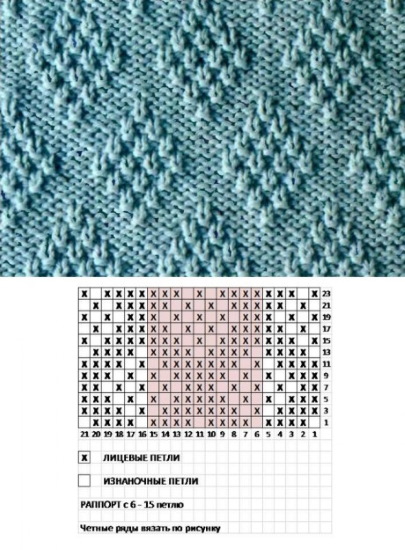 | 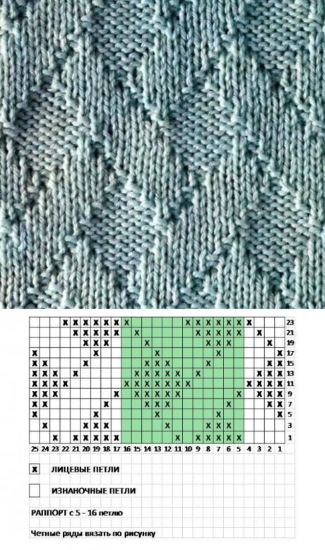 |
Step by step:
- For the pattern fragment, cast on 30 stitches onto the knitting needles.
- Row 1 begins with an edge loop, 6 ip, 1 lp. The pattern is repeated throughout the row, and the last loop in the row is a purl.
- The initial edge loop in the following rows should be removed, and the last loop is knitted purlwise.
- Row 2 consists of 2 ip and 5 lp.
- Row 3 is a combination of 4 ip and 3 lp.
- Row 4 is knitted in the same way as row 3.
- Row 5 is knitted in the same way as row 2.
- In row 6, the pattern of row 1 is repeated.
Shadow knitting is a simple and popular type of creativity among craftswomen. This type of knitting does not have a large number of shades and halftones, so beginning needlewomen often create works in this technique.
Shadow knitting patterns can be used to work on men's, women's and children's items, making this technique universal.
Video about knitting
Shadow knitting:
